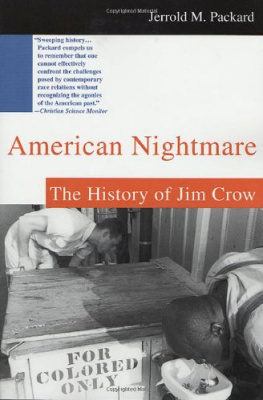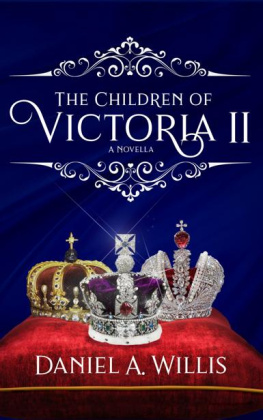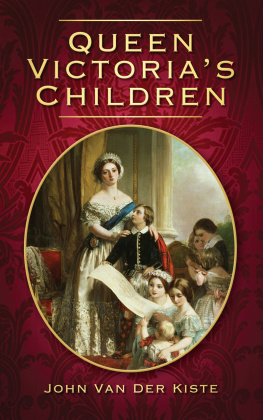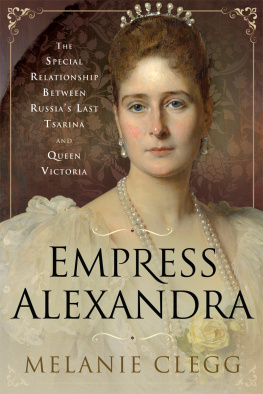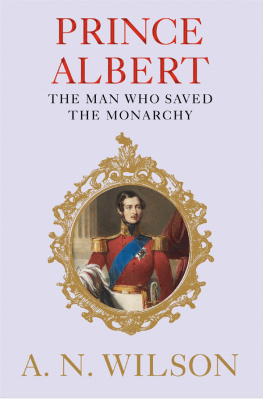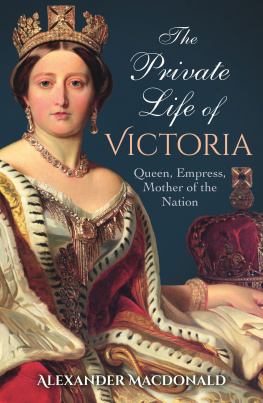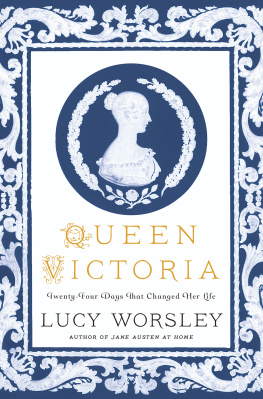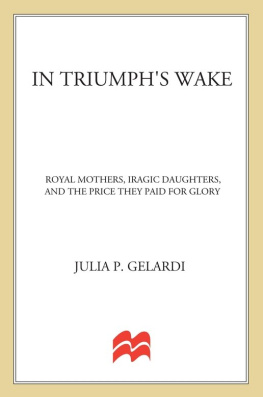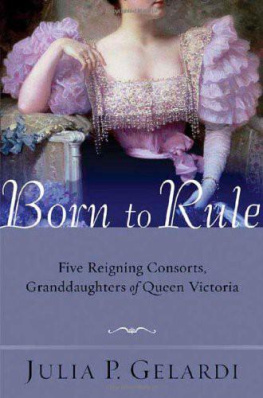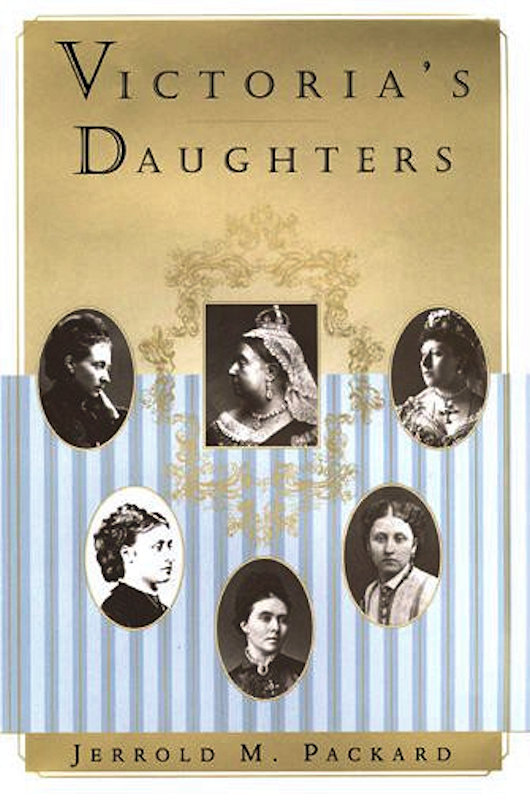Windsor Castle
FRIDAY, NOVEMBER 3, 1944
D eath had come as gently as sleep to Victoria and Alberts last child. Princess Beatrice, ninth born and fifth daughter, had always been the baby to her august mother, but now her name recalled only the haziest of memories for most. The world she symbolized was buried beyond recall, first in Flanders mud, more lately in a Europe being laid waste a second time. Yet at her passing, a distinguished company of Beatrices countrymen broke off from their urgent wartime duties to gather and to remember what this woman had once been to their kingdom.
Shortly before noon on this late autumn morning, the Blitz having painfully returned to Britain in the form of pilotless German rockets, a bone-weary King George VI led the mournersmostly members of Europes extended royal clanin bidding his great-aunt Bee a subdued good-bye. The scene was played out at St. Georges Chapel, for centuries the de facto parish church to Englands royal family, and where only a few emblems of the usual splendor associated with this renowned place of worship were in evidence this morning. But there was no question of the high rank of the deceased: not only did the archbishop of Canterbury and thedean of Windsor lend their eminence to the ceremony, but the dozens of brilliantly emblazoned Garter knights banners, since 1939 removed from the stalls because of the danger from air raids, had at the monarchs command been returned as a mark of respect to the dead princess.
Joining the sovereign at the side of the coffin were members of most of Europes royal families, including the kings of Norway and of the Hellenes, the deceaseds nieces Princesses Helena Victoria and Marie Louise, andas chief mournerthe long-exiled queen of Spain, Beatrices daughter, Victoria Eugenia. The congregants displayed little grandeur, most of the men dressed in the winter uniforms of the armed servicesthe British king was attired as a fleet admiralwhile the women were hidden in the plain and somber black of mourning.
With the failing light of an autumn sun only just illumining the medieval setting, Britains queen consort led her Spanish counterpart to the edge of the exposed vault. The two women dropped low curtsies over the coffin. A future queen, the eighteen-year-old Princess Elizabeth, watched solemnly from a few feet away as her parents presided over the homage to a spent generation.
Even though many of the mourners had passed their own lifetimes in Europes palaces, only a fewonly the very oldestcould know the endless splendors that had passed before Princess Beatrices eyes over her eighty-seven years, the first half of which had been spent at the elbow of the nineteenth-centurys greatest monarch and the woman for whom a long era had been named. The titles of Her Royal Highness Princess Beatrice Mary Victoria Feodore were read aloud by the Garter King of Arms, then slowly the gathering turned and left the chapel to face the dangers and uncertainties of a countrya worldat war and yearning for peace. But the last of Queen Victorias illustrious daughters was already at peace.
Foundations
S ince neither the queen nor her new husband had the first idea how pregnancy might be avoided, only weeks after her wedding the amazed Victoria found herself, not particularly happily, with child. The expectant mother suppressed her horror of what she called the shadow side of marriage and resolved to look upon the approaching event with something like equanimity. Both parents were determined to give their kingdom a male heir, such production representing the most fundamental duty of sovereign mother and consort father. Thus it happened that in the early hours of November 21, 1840, a rainy day Victoria remembered most clearly for the smoking chimneys outside her bedroom windows, the young queens labor pains began, a week or two earlier than her doctors had predicted.
Because of the low state of medicine in the early nineteenth century, childbirth was still a largely primitive undertaking. Though royal deliveries were conducted with a degree of care far exceeding that received by most of her kingdoms mothers, the effort had, in truth, killed the queens aunt, a tragedy most responsible for putting Victoria on the throne. This unique position she nowfilled with a prideful mix of noblesse oblige and the assuredness that it had been Gods own plan. Indeed, it did appear that divine facilitation had led some three and a half years earlier to the accession of the eighteen-year-old princess to Britains throne.
To understand how Victoria became queen of England, it is necessary to look back a few decades, to the reign of her grandfather, King George III, and his queen, Charlotte. George, the prince of Wales, the couples eldest child, had to the surprise of many fulfilled his dynastic duty by contracting for a lawful marriage, relatively late in lifehe was already in his thirties when he went to the altar. Others, however, accurately foresaw the failure of that enterprise, since his bride-to-be was a woman whose tastes differed in almost every particular from those of her reluctant fianc.
To complicate the situation, the royal groom had already been marriedalthough his first marriage, to the Roman Catholic widow Maria Fitzherbert, was officially kept secret: marriage between any heir to the British throne and a Catholic was impermissible under the law as it then stood, and to this day continues so. Because of its illegality, Georges marriage to Mrs. Fitzherbert had been contracted in an essentially morganatic state (though Britain didnt and still legally doesnt recognize this either), which meant that his wife could not assume rank as princess of Wales, nor could any children of that union have inherited rank, titles, or rights to the throne from their father. Though on becoming king George could have made Mrs. Fitzherbert his queenshe was already widely called Princess Fitzsuch an act would have brought disapprobation from every European court, as well as grave constitutional questions as to the legitimacy of Britains crown, a matter taken by royalty of the early nineteenth century with massive seriousness, and therefore not a course likely to have been followed by a fourth King George.
Mrs. Fitzherberts star began to be overshadowed in the mid-1790s when George took a sudden passion for new lovers, first LadyJersey, later Lady Hertford. It was actually debts incurred during his illegal marriage that most directly prompted the prince to contract an approved marriage as a means of regularizing his purse. George abruptly divorced Mrs. Fitzherbert, even though he swore he still loved her. He surely was mollified, however, by Parliaments promise that in return for making a dynastically valid union, it would pay off his vast debts and generously increase his state allowance.
In 1794, George asked Lady Jersey, his hitherto standby mistress, to see what she might be able to find him by way of a suitably Protestant princess. It is perhaps understandable that she did not wish to recommend anyone who would diminish her own standing with the prince. In view of the resultsLady Jerseys intervention proved catastrophicGeorge would have been better off asking the help of a less personally interested intermediary.
What she came up with turned out to be one of Europes least appealing princesses. Caroline of Brunswick was royalin fact, Georges first cousin (her mother was the sister of his father)but that about covered her commendable qualities, aside from the prospective grooms belief the connection would please her uncle, his father. On the negative side, Carolines speech was uncouth, her appearance astoundingly unregal, her bodily hygiene verging on the barbaric. Georges cultured tastes clearly stood diametrically opposed to the princesss general lowness. The courtier Lord Malmesbury was nonetheless dispatched to Germany to inspect and negotiate. When in 1795 Caroline arrived in England and George first saw what his ill-luck had brought him, he immediately called out to his valet for a brandy.


